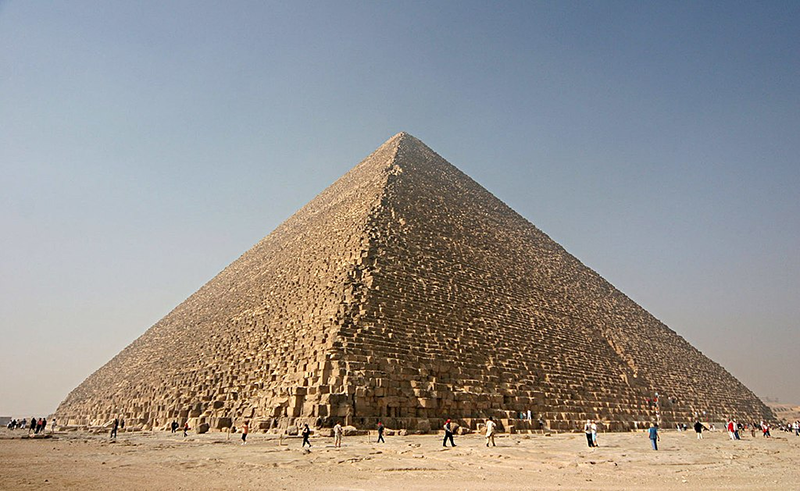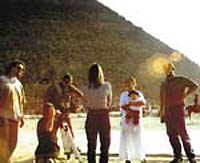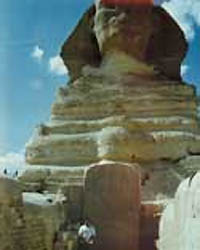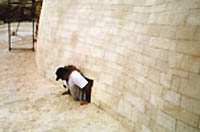
There they hit the Red Granite casing on one of the interior passages and by following it (the tools they had couldn’t cut granite), they eventually located the Great Pyramid’s interior. From the end of this tunnel, one climbs about 120 ft (36.6 m) stooped over in a space barely 1 yard/meter high.
This section is fairly steep with an approximate 30-degree incline. Without the wooden boards fastened to the stone for footing, it would be almost impossible to make this climb while carrying gear. For me, this path created a whole new meaning to the term “walk like an Egyptian.”
Walking With The King
Next you enter the Grand Hall. It’s also inclined but now about 40 ft (12.2 m) tall with a corbled (stepped) ceiling. After trudging up another 120 ft (36.6 m) up the grand hall one finally reaches the entry to the King’s Chamber, which is another tunnel. This time, however, it’s level and about 10 sq.ft (1 sq.m) and perhaps 20 ft (6.1 m) long.
The King’s Chamber is about 40 ft (12.2 m) long, 20 ft (6.1 m) wide and 20 ft (6.1 m) high. The walls, floor and ceiling are all made of Red Granite. The granite blocks that make up the walls are huge. The one over the door is nearly 8 ft (2.4 m) high 14 ft (4.3 m) long and 5 ft (1.5 m) thick, yet all the blocks fit so tightly you can’t get a business card between them. They are polished to a surprisingly smooth finish.
However, it was kind of a pain just to get this far (and this was the easy part). When I expressed concern about getting the gear up to the King’s Chamber, I was encouraged to hear the producer’s plan to hire some locals to haul our gear in and out. He acknowledged the degree of difficulty, and he was right.
The producer was also right about the acoustics in the King’s Chamber. It sounded very weird inside there. Think of the “livest room” you’ve ever experienced, and then double that. It was acoustically “solid as a rock.” Given a minimum of 200 ft (61 m) of stone in all directions, it should be.
On The Skids
Our crew had a heavy heap of equipment (larger than my gear pile). So, our fearless leader decided we would go to a wood shop and have a skid made that could be dragged up the incline. After measuring the passages, we were off the next day to find a “wood shop” known to the staff’s hired Egyptian cab driver.
When we arrived at the shop, I was underwhelmed to say the least. Our wooden skid was promised to be ready in a few days. The crew (Photo 2) were already scheduled to explore/plan for other parts of the film, so I tagged along. During these few days it became obvious that the producer and his financial backers were following two somewhat different game plans.

“Plan A” included the production goals that included me. Specifically, we sought to access the cavity they had found with sonar and ground penetrating radar under the paw of the Sphinx. Psychic/cult hero Edgar Cayce predicted this cavity to be there in the 1930s.
“Plan B” was to produce a TV documentary, which overlapped Plan A as much as possible. We had permits that essentially gave us free access to everything, so we spent a couple days filming at the Sphinx compound (Photo 3). Note: I ate lunch one day sitting between its paws.

The radar also suggested there was an underground tunnel leading from the cavity, under the sphinx and continuing on. At the rear of the Sphinx, the sound guy and myself saw an opening at the bottom of its rear and after seeing no one was around, both of us went in (Photo 4).

This cave has two forks. One fork goes down about 12 ft (3.6 m) and sounds hollow if you stomp on the floor. The other fork goes up into the body and stops.
There were no other ways of reaching the cavity and by this time the permit to drill a hole for a fiber optic camera had mysteriously been yanked by the antiquities department. Being problem solvers, the bosses decided to look for another way to reach the Sphinx cavity.
